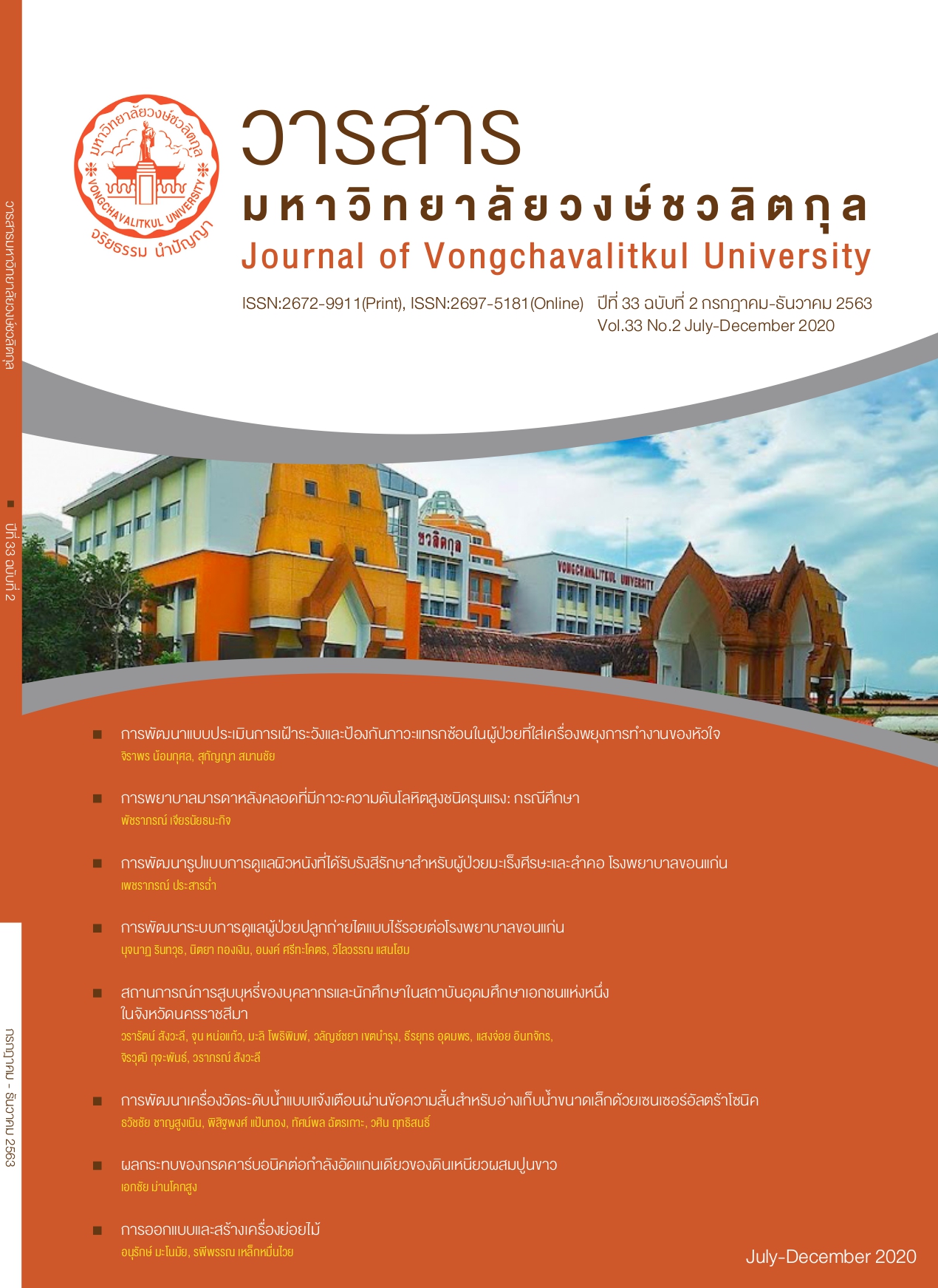การพัฒนาแบบประเมินการเฝ้าระวังและป้องกันภาวะแทรกซ้อนในผู้ป่วยที่ใส่เครื่องพยุงการทำงานของหัวใจ
Main Article Content
บทคัดย่อ
วัตถุประสงค์: เพื่อพัฒนาแบบประเมินการเฝ้าระวังภาวะแทรกซ้อนในผู้ป่วยใส่เครื่อง IABP
วิธีการวิจัย: เป็นการวิจัยพัฒนา กลุ่มตัวอย่างคือ ผู้ป่วยใส่เครื่อง IABP จำนวน 58 คน แพทย์และพยาบาลวิชาชีพ จำนวน 20 คน โรงพยาบาลขอนแก่น เก็บข้อมูลจากเวชระเบียน และการสัมภาษณ์ วิธีการศึกษาแบ่งเป็น 4 ระยะ 1) วิเคราะห์สถานการณ์การดูแลผู้ป่วยใส่เครื่อง IABP 2) สร้างแบบประเมิน 3) การนำใช้แบบประเมิน 4) การประเมินผล วิเคราะห์ข้อมูลเชิงปริมาณโดยใช้ความถี่ ร้อยละ และค่าเฉลี่ย
ผลการวิจัย: 1) ผลการวิเคราะห์สถานการณ์จากการทบทวนเวชระเบียนและสังเกต พบว่าการประเมินภาวะแทรกซ้อนในผู้ป่วยใส่เครื่อง IABP ยังไม่ครอบคลุม และไม่มีแบบประเมิน พยาบาลส่วนใหญ่มีประสบการณ์น้อยกว่า 5 ปี และการดูแลผู้ป่วยมีความหลากหลายไม่เป็นแนวทางเดียวกันผู้ป่วยเกิดภาวะแทรกซ้อนได้รับการตัดขา 1 ราย 2) แบบประเมินการเฝ้าระวังและป้องกันภาวะแทรกซ้อนในผู้ป่วยใส่เครื่อง IABP ที่พัฒนาขึ้นประกอบด้วย ผังแนวทางการดูแลผู้ป่วยใส่เครื่อง IABP และแบบการประเมินการเฝ้าระวังป้องกันภาวะแทรกซ้อน 3) ผลการนำใช้แบบประเมินการเฝ้าระวังและป้องกันภาวะแทรกซ้อนในผู้ป่วยใส่เครื่อง IABP พบ 3.1) อัตราการเกิดภาวะ Thrombocytopenia ร้อยละ 20.69 3.2) อัตราการเกิด Hematoma ร้อยละ 17.24 3.3) อัตราการเกิด Acute Limb ischemia ร้อยละ 8.62 3.4) อัตราการเกิด Infection ร้อยละ 6.90 ทั้งนี้สามารถรายงานและแก้ไขได้ทันทุกราย ไม่พบผู้ป่วยถูกตัดขา 4) การประเมินผล พยาบาลทุกคนใช้แบบประเมินการเฝ้าระวังและป้องกันภาวะแทรกซ้อนในผู้ป่วยที่ใส่เครื่อง IABP ความพึงพอใจการใช้แบบประเมิน พบว่าแพทย์และพยาบาลผู้ใช้แบบประเมินมีความพึงพอใจระดับดีมาก ร้อยละ 92.5 ผู้ป่วยและญาติมีความพึงพอใจต่อการเฝ้าระวังป้องกันภาวะแทรกซ้อนในผู้ป่วยใส่เครื่อง IABP ระดับดีมาก ร้อยละ 90
Article Details
เอกสารอ้างอิง
2. ธนุธร วงศ์ธิดา, วัฒนา วงศ์เทพเตียน และ ชยันตร์ธร ปทุมานนท์. (2560). ลักษณะเสี่ยงทางคลินิกที่มีผลต่ออาการรุนแรงที่เกิดขึ้นอย่างไม่คาดคิดในผู้ป่วยกล้ามเนื้อหัวใจตายเฉียบพลันชนิด ST-Segment ยกสูงภายหลังรักษาด้วยวิธีถ่างขยายหลอดเลือดหัวใจ. วารสารพยาบาลโรคหัวใจและทรวงอก, 28(2), 52-67.
3. แบบประเมินการดำเนินงานในการป้องกันcละควบคุมการติดเชื้อในระดับโรงพยาบาล. (มปท.). แบบประเมินการดำเนินงานในการ ป้องกันและควบคุมการติดเชื้อในระดับโรงพยาบาล. [Online] www.who.int/ infection- prevention/ tools/hand-hygiene/ipcaf_thai.pdf
4. ผนึกแก้ว คลังคา, วิลาวัณย์จันโทริ และอำภา ทาเวียง. (2562). การพัฒนารูปแบบการวางแผนจำหน่ายผู้ป่วยเด็กโรคปอดอักเสบโดยการมีส่วนร่วมของครอบครัวหรือผู้ดูแล. วารสารมหาวิทยาลัยวงษ์ชวลิตกุล, 32(2), 40-49.
5. ภาวดี วิมลพันธุ์, พรทิวา คำวรรณ, นลินี แข็งสาริกิจ และ กัตติกา พิงคะสัน. (2555). การพัฒนาแนวปฏิบัติทางการพยาบาลเพื่อจัดการกับความเจ็บปวดของผู้ป่วยมะเร็ง. วารสารการพยาบาลและการศึกษา, 5(3), 2-15.
6. มลธนัฎ มาปุก. (2553). แนวปฏิบัติการพยาบาลผู้ป่วยเบาหวานในคลินิกเบาหวาน. วิทยานิพนธ์ปริญญาพยาบาลศาสตรมหาบัณฑิต (สาขาวิชาการพยาบาลผู้ใหญ่
ขั้นสูง), บัณฑิตวิทยาลัย, มหาวิทยาลัยคริสเตียน.
7. วิภา หาทอน และ เพ็ญจันทร์ เลิศรัตน์. (2555). การพัฒนาแนวปฏิบัติการพยาบาลเพื่อป้องกันและดูแลหลังหกล้มในผู้ป่วยสูงอายุที่มีความบกพร่องด้านการมองเห็น หอผู้ป่วยจักษุ โรงพยาบาลขอนแก่น. รายงานการศึกษาอิสระปริญญาพยาบาลศาสตรมหาบัณฑิต, สาขาวิชาการพยาบาลผู้สูงอายุ, คณะพยาบาลศาสตร์, มหาวิทยาลัยขอนแก่น.
8. อักษรภัค บัวศรี. (2556). การพัฒนาแนวปฏิบัติ การพยาบาลทางคลินิกสำหรับผู้สูงอายกลุ่มอาการโรคหัวใจขาดเลือด เฉียบพลัน แผนกอุบัติเหตุและฉุกเฉิน โรงพยาบาลจตุรพักตรพิมาน จังหวัดร้อยเอ็ด. วิทยานิพนธ์ พยาบาลศาสตรมหาบัณฑิตสาขาวิชาการพยาบาลผู้สูงอายุ คณะพยาบาลศาสตร์มหาวิทยาลัยบูรพา.
9. Christopher, A-J. W., Paul, D. W., & Brigid, C. F. (2015). Management of Intra-Aortic Balloon Pumps. Seminars in Cardiothoracic and Vascular Anesthesia, 19(2), 106–121.
10. Cohen, M., Dawson, M. S., & Kopistansky, C., (2004). Sex and other predictors of intra-aortic balloon therapy in intra-aortic balloon counter pulsation: Does IABP really need anti-coagulation? Journal of Thoracic Cardiovascular Surgery, 127, 1309-1316.
11. Ludwig, Van Bertalanffy. (1998). Toward a System theory of Organization. Seaside, CA: Inter-systems Publication.
12. Mullasari, A. S., Balaji, P., & Khando, T. (2011). Managing complications in acute myocardial infarction. Journal of Association of Physicians in India, 59, 43-48.
13. Parissis, H., Graham, V., Lampridis, S., Lau, M., Hooks, G., & Mhandu, P. C. (2016). IABP: History-evolution-pathophysiology-indication: What we need to know. Journal of Cardiothoracic Surgery, 11(1), 122.
14. Soukup, S. M. (2000). The center for advanced nursing practice evidence-based practice model promoting the scholarship of practice. In S. M. Soukup & C. F. Beason (Eds.), Nursing Clinic of North America (pp.301-309). Philadelphia: W. B. Saunders.
15. Thiele, H., Ohman, E. M., & Desch, S. (2015). Management of cardiogenic shock. European Heart Journal, 36, 1223–1230.


